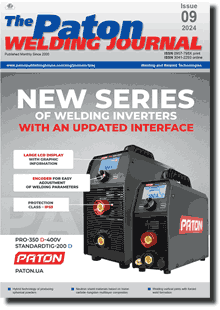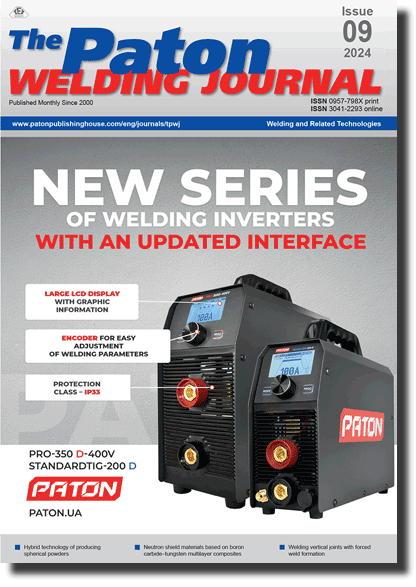| 2024 №09 (05) |
DOI of Article 10.37434/tpwj2024.09.06 |
2024 №09 (01) |

The Paton Welding Journal, 2024, #9, 44-49 pages
Reinforcement of an NPP pipeline with a wall thinning defect by applying external weld overlay
G.V. Vorona, O.S. Kostenevych, O.S. Milenin, O.V. Makhnenko
E.O. Paton Electric Welding Institute of the NASU. 11 Kazymyr Malevych Str., 03150, Kyiv, Ukraine. E-mail: makhnenko@paton.kiev.uaAbstract
Repair of NPP pipelines with erosive and corrosive wear defects is an urgent problem of the nuclear power industry of Ukraine. When repairing the pipeline, the defective section is cut out and a new pipe coil is installed by welding. However, for a large number of technological pipelines with identified isolated defects, inadmissible wall thinning, replacement of a pipe section is associated with a large volume of repair work. To extend the service life, the defective section of the pipeline can be reinforced, for example, by welding an external overlay, weld deposition, installing a bandage or a welded sleeve. In order to justify the expediency of using reinforcing structures of welded external overlay type at pipeline repair, a finite element analysis of the stress-strain state of a straight section of the pipeline with an erosion-corrosion wear defect under the action of internal pressure before and after repair was carried out. The results of the analysis showed a high efficiency of reinforcement the defective section of the pipeline in the case of using a welded external overlay at repair. The obtained results can be used at justifying the introduction of alternative pipeline repair technologies at NPPs of Ukraine.
Keywords: NPP, pipeline, erosion-corrosion wear, wall thinning defect, reinforcing structure, welded external overlay, stress-strain state, ductile fracture, finite element method
Received: 23.04.2024
Received in revised form: 10.06.2024
Accepted: 03.09.2024
References
1. (2011) GBN V.3.1-00013741-12:2011. Main gas pipelines. Repair by arc welding in service conditions. Ministry of Energy and Coal of Ukraine [in Ukrainian].2. Jaske, Carl E., Hart, Brian O., Bruce, William A. (2006) Updated pipeline repair manual. R2269-01R, United States.
3. Repair of pressure equipment and piping. An American national standard. ASME PCC-2-2018 (Revision of ASME PCC-2-2015).
4. Vorona, G.V., Makhnenko, O.V., Milenin, O.S. (2023) Effectiveness of unloading a section of NPS pipeline with a pipe wall thinning defect by mounting a band or welded sleeve. Tekh. Diahnost. ta Neruiniv. Kontrol, 4, 11-19 [in Ukrainian]. https://doi.org/10.37434/tdnk2023.04.02
5. (2019) MT-T.0.03.224-18: Procedure for determination of acceptable thicknesses of NPP pipeline elements from carbon steels subjected to erosion-corrosion wear. NAEK Energoatom [in Russian].
6. (1989) PNAE G-7-002-86: Norms of strength analysis of equipment and pipelines of nuclear power plants. Moscow, Energoatomizdat [in Russian].
7. Milenin, A., Velikoivanenko, E., Rozynka, G., Pivtorak, N . (2019) Probabilistic procedure for numerical assessment of corroded pipeline strength and operability. Int. J. of Pressure Vessels and Piping, 171, 60-68. https://doi.org/10.1016/j.ijpvp.2019.02.003
8. Timoshenko, S.P., Voinovsky-Krieger, S. (1966) Plates and shells. Moscow, Nauka [in Russian].
Suggested Citation
G.V. Vorona, O.S. Kostenevych, O.S. Milenin, O.V. Makhnenko (2024) Reinforcement of an NPP pipeline with a wall thinning defect by applying external weld overlay. The Paton Welding J., 09, 44-49.The cost of subscription/purchase order journals or individual articles
| Journal/Currency | Annual Set | 1 issue printed |
1 issue |
one article |
| TPWJ/USD | 384 $ | 32 $ | 26 $ | 13 $ |
| TPWJ/EUR | 348 € | 29 € | 24 € | 12 € |
| TPWJ/UAH | 7200 UAH | 600 UAH | 600 UAH | 280 UAH |
| AS/UAH | 1800 UAH | 300 UAH | 300 UAH | 150 UAH |
| AS/USD | 192 $ | 32 $ | 26 $ | 13 $ |
| AS/EUR | 180 € | 30 € | 25 € | 12 € |
| SEM/UAH | 1200 UAH | 300 UAH | 300 UAH | 150 UAH |
| SEM/USD | 128 $ | 32 $ | 26 $ | 13 $ |
| SEM/EUR | 120 € | 30 € | 25 € | 12 € |
| TDNK/UAH | 1200 UAH | 300 UAH | 300 UAH | 150 UAH |
| TDNK/USD | 128 $ | 32 $ | 26 $ | 13 $ |
| TDNK/EUR | 120 € | 30 € | 25 € | 15 € |
AS = «Automatic Welding» - 6 issues per year;
TPWJ = «PATON WELDING JOURNAL» - 12 issues per year;
SEM = «Electrometallurgy Today» - 4 issues per year;
TDNK = «Technical Diagnostics and Non-Destructive Testing» - 4 issues per year.


